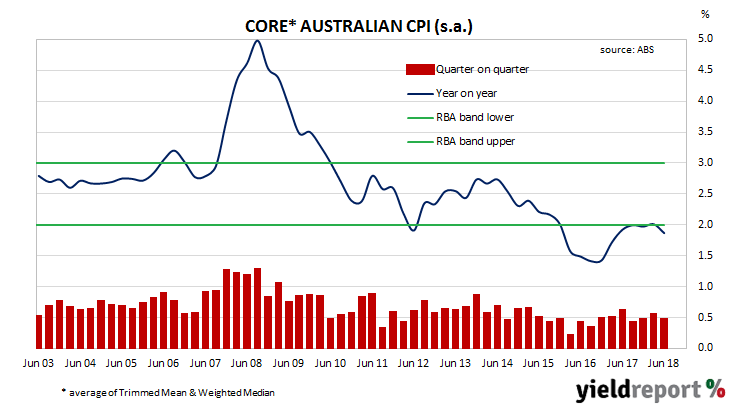Inflation was once a problem in Australia. Through the 1970s and 1980s, consumer inflation regularly exceeded 5%, even though real GDP growth rates were on the low side and were far from buoyant levels. This combination of high inflation rates and low economic growth rates was termed “stagflation” and it existed in most advanced economies at the time.
In 1990/1991, inflation in Australia was broken by a deep recession which would become known as the “recession we had to have”, in reference to the then-Treasurer Paul Keating’s description of it. Since June 1991, inflation rates as measured by changes in the consumer price index have averaged around 2.4%.
Figures for the June quarter have now been released by the ABS and the headline number was weaker than the expected 0.5% while seasonally-adjusted and core inflation figures were in line. Headline inflation was 0.4% for the quarter while seasonally-adjusted inflation produced a 0.5% reading. On a 12-month basis, headline inflation recorded 2.1%, up from 1.9% in the March quarter, while the seasonally-adjusted rate increased from a revised 2.0% to 2.2%. Financial markets reacted by sending yields, the Aussie dollar and the chances of an official rate rise lower. 3 year and 10 year bond yields each fell a couple of basis points immediately after the report was released. They then drifted a little lower over the rest of the day to finish 3bps lower at 2.14% and 2.69% respectively. The local currency had been rising in the lead up to the release of the figures but as soon as the numbers appeared the Aussie fell and settled at a bit over 74 US cents. Changes to cash futures prices implied a reduced likelihood of an RBA rate rise in any given month through 2018 and 2019, with August 2019 now viewed as a 52% probability.
Financial markets reacted by sending yields, the Aussie dollar and the chances of an official rate rise lower. 3 year and 10 year bond yields each fell a couple of basis points immediately after the report was released. They then drifted a little lower over the rest of the day to finish 3bps lower at 2.14% and 2.69% respectively. The local currency had been rising in the lead up to the release of the figures but as soon as the numbers appeared the Aussie fell and settled at a bit over 74 US cents. Changes to cash futures prices implied a reduced likelihood of an RBA rate rise in any given month through 2018 and 2019, with August 2019 now viewed as a 52% probability.

